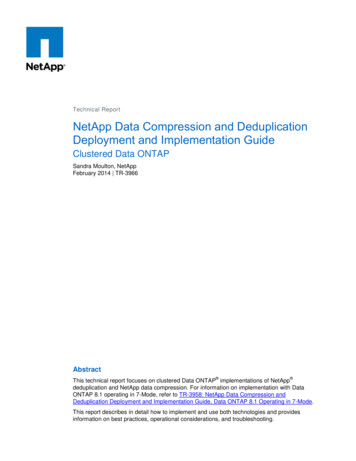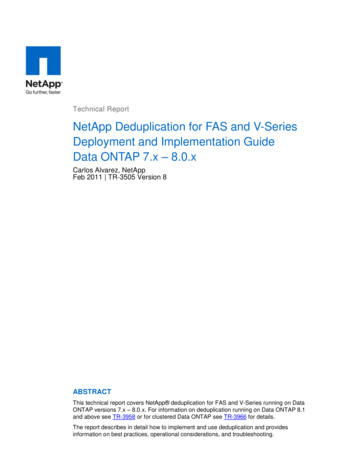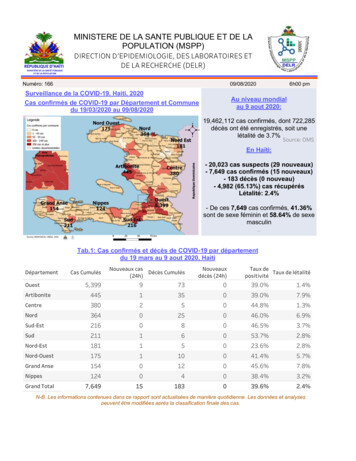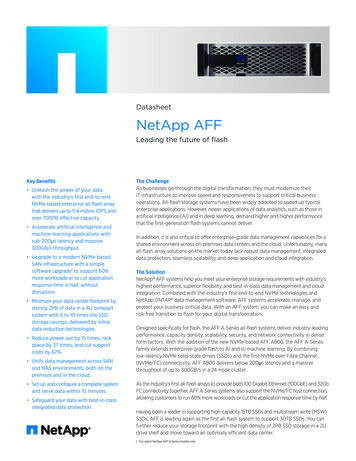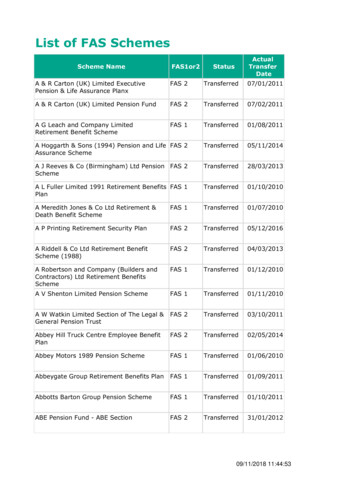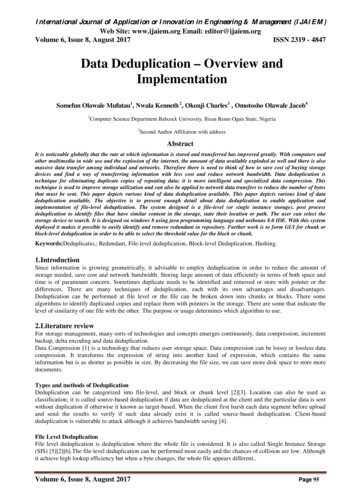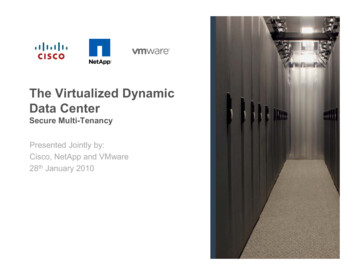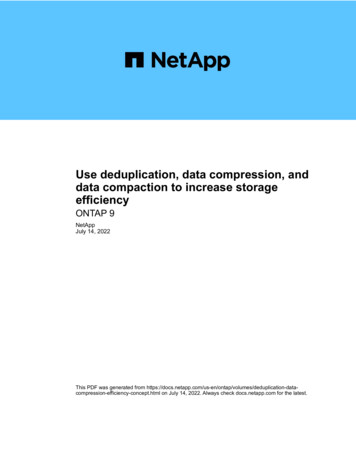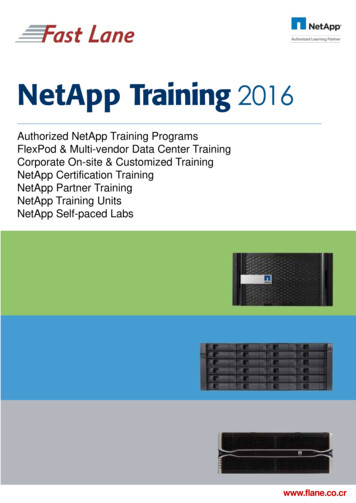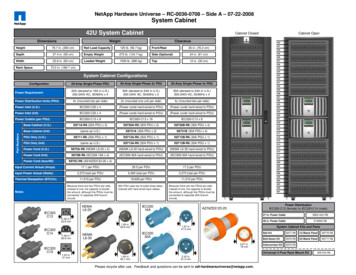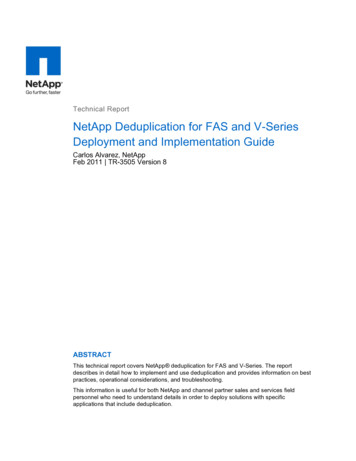
Transcription
Technical ReportNetApp Deduplication for FAS and V-SeriesDeployment and Implementation GuideCarlos Alvarez, NetAppFeb 2011 TR-3505 Version 8ABSTRACTThis technical report covers NetApp deduplication for FAS and V-Series. The reportdescribes in detail how to implement and use deduplication and provides information on bestpractices, operational considerations, and troubleshooting.This information is useful for both NetApp and channel partner sales and services fieldpersonnel who need to understand details in order to deploy solutions with specificapplications that include deduplication.
TABLE OF CONTENTS1 DEPLOYMENT AND IMPLEMENTATION GUIDE . 62 INTRODUCTION AND OVERVIEW OF NETAPP DEDUPLICATION . 63 NETAPP DEDUPLICATION FOR FAS AND V-SERIES . 73.1DEDUPLICATED VOLUMES . 83.2DEDUPLICATION METADATA . 93.3GENERAL DEDUPLICATION FEATURES . 104 CONFIGURATION AND OPERATION . 104.1OVERVIEW OF REQUIREMENTS. 114.2INSTALLING AND LICENSING DEDUPLICATION . 124.3COMMAND SUMMARY . 124.4INTERPRETING SPACE USAGE AND SAVINGS . 134.5DEDUPLICATION QUICK START. 144.6END-TO-END DEDUPLICATION EXAMPLES . 144.7CONFIGURING DEDUPLICATION SCHEDULES. 195 SIZING FOR PERFORMANCE AND SPACE EFFICIENCY. 215.1BEST PRACTICES. 215.2PERFORMANCE. 215.2.1PERFORMANCE OF THE DEDUPLICATION OPERATION. 225.2.2IMPACT ON THE SYSTEM DURING DEDUPLICATION . 225.2.3I/O PERFORMANCE OF DEDUPLICATED VOLUMES . 235.2.4PAM AND FLASH CACHE CARDS. 235.3SPACE SAVINGS . 245.3.1TYPICAL SPACE SAVINGS BY DATASET . 245.3.2SPACE SAVINGS ON EXISTING DATA . 255.3.3DEDUPLICATION METADATA OVERHEAD. 255.3.4SPACE SAVINGS ESTIMATION TOOL . 265.4LIMITATIONS . 275.4.1GENERAL CAVEATS . 275.4.2MAXIMUM FLEXIBLE VOLUME SIZE. 275.4.3MAXIMUM SHARED DATA LIMIT FOR DEDUPLICATION. 305.4.4MAXIMUM TOTAL DATA LIMIT FOR DEDUPLICATION. 305.4.5NUMBER OF CONCURRENT DEDUPLICATION PROCESSES. 326 DEDUPLICATION WITH OTHER NETAPP FEATURES. 3326.1MANAGEMENT TOOLS . 336.2DATA PROTECTION . 33NetApp Deduplication for FAS and V-Series, Deployment and Implementation Guide
6.2.1SNAPSHOT COPIES . 336.2.2SNAPRESTORE. 336.2.3VOLUME SNAPMIRROR . 346.2.4QTREE SNAPMIRROR . 356.2.5SNAPVAULT . 366.2.6OPEN SYSTEMS SNAPVAULT (OSSV) . 376.2.7SNAPMIRROR SYNC . 386.2.8SNAPLOCK. 386.3CLUSTERING TECHNOLOGIES. 386.3.1DATA ONTAP CLUSTER-MODE . 386.3.2ACTIVE-ACTIVE CLUSTER CONFIGURATION . 396.3.3METROCLUSTER . 406.4OTHER NETAPP FEATURES . 406.4.1QUOTAS. 406.4.2FLEXCLONE VOLUMES . 406.4.3FLEXCLONE FILES . 416.4.464-BIT AGGREGATE SUPPORT . 426.4.5FLEXCACHE . 426.4.6NONDISRUPTIVE VOLUME MOVEMENT . 426.4.7NETAPP DATA MOTION . 426.4.8PERFORMANCE ACCELERATION MODULE AND FLASH CACHE CARDS . 436.4.9SMTAPE . 436.4.10 DUMP . 436.4.11 NONDISRUPTIVE UPGRADES . 436.4.12 NETAPP DATAFORT ENCRYPTION . 446.4.13 READ REALLOCATION (REALLOC) . 446.4.14 VOL COPY COMMAND . 446.4.15 AGGREGATE COPY COMMAND . 456.4.16 MULTISTORE (VFILER) . 456.4.17 SNAPDRIVE . 456.4.18 LUNS . 457 DEDUPLICATION BEST PRACTICES WITH SPECIFIC APPLICATIONS . 497.13VMWARE BEST PRACTICES . 497.1.1VMFS DATASTORE ON FIBRE CHANNEL OR ISCSI: SINGLE LUN . 517.1.2VMWARE VIRTUAL DISKS OVER NFS/CIFS . 527.1.3DEDUPLICATION ARCHIVE OF VMWARE. 53NetApp Deduplication for FAS and V-Series, Deployment and Implementation Guide
7.2MICROSOFT SHAREPOINT BEST PRACTICES . 547.3MICROSOFT SQL SERVER BEST PRACTICES. 547.4MICROSOFT EXCHANGE BEST PRACTICES. 547.5LOTUS DOMINO BEST PRACTICES. 557.5.1DOMINO ATTACHMENT AND OBJECT SERVICE (DAOS) . 557.5.2DOMINO ENCRYPTION. 557.5.3DOMINO QUOTAS. 557.5.4DOMINO PERFORMANCE . 557.6ORACLE BEST PRACTICES . 567.7TIVOLI STORAGE MANAGER BEST PRACTICES. 567.8SYMANTEC BACKUP EXEC BEST PRACTICES . 567.9BACKUP BEST PRACTICES . 578 TROUBLESHOOTING . 578.18.1.18.2CHECK DEDUPLICATION LICENSING . 57MAXIMUM VOLUME AND DATA SIZE LIMITS . 588.2.1MAXIMUM VOLUME SIZE LIMIT. 588.2.2MAXIMUM SHARED DATA LIMIT FOR DEDUPLICATION. 608.2.3MAXIMUM TOTAL DATA LIMIT . 608.3DEDUPLICATION SCANNER OPERATIONS TAKING TOO LONG TO COMPLETE. 628.4LOWER-THAN-EXPECTED SPACE SAVINGS . 628.5SYSTEM SLOWDOWN . 638.5.1UNEXPECTEDLY SLOW READ PERFORMANCE CAUSED BY ADDING DEDUPLICATION. 638.5.2UNEXPECTEDLY SLOW WRITE PERFORMANCE CAUSED BY ADDING DEDUPLICATION . 648.5.3SYSTEM RUNNING MORE SLOWLY SINCE ENABLING DEDUPLICATION. 658.6REMOVING SPACE SAVINGS (UNDO). 658.6.1UNDEDUPLICATING A FLEXIBLE VOLUME. 668.6.2UNDEDUPLICATING A FLEXIBLE VOLUME. 678.6.3REVERTING A FLEXIBLE VOLUME TO BE ACCESSIBLE IN OTHER DATA ONTAP RELEASES . 688.7WHERE TO COLLECT TROUBLESHOOTING INFORMATION. 688.7.1LOCATION OF LOGS AND ERROR MESSAGES. 688.7.2UNDERSTANDING DEDUPLICATION ERROR MESSAGES . 688.7.3UNDERSTANDING OPERATIONS MANAGER EVENT MESSAGES. 698.88.8.18.94DEDUPLICATION WILL NOT RUN . 57ADDITIONAL DEDUPLICATION REPORTING. 69DEDUPLICATION REPORTING WITH SIS STATUS. 69DEDUPLICATION REPORTING WITH SIS STAT. 70NetApp Deduplication for FAS and V-Series, Deployment and Implementation Guide
8.10WHERE TO GET MORE HELP. 738.10.1 CONTACT INFORMATION FOR SUPPORT . 738.10.2 INFORMATION TO GATHER BEFORE CONTACTING SUPPORT . 739 ADDITIONAL READING AND REFERENCES . 7310 VERSION TRACKING . 75LIST OF TABLESTable 1) Overview of deduplication requirements. .11Table 2) Deduplication commands. .12Table 3) Interpreting df -s results.13Table 6) Deduplication quick start. .14Table 7) Typical deduplication space savings. .24Table 8) Maximum supported volume sizes for deduplication.29Table 9) Maximum total data limit in a deduplicated volume.31Table 10) Maximum total data limit example for deduplication.32Table 11) Maximum supported volume sizes for deduplication.59Table 12) Example illustrating maximum total data limit - deduplication only. .60Table 13) Maximum total data limit in a deduplicated volume.61LIST OF FIGURESFigure 1) How NetApp deduplication works at the highest level. .7Figure 2) Data structure in a deduplicated volume.8Figure 3) VMFS data store on Fibre Channel or iSCSI - single LUN3. .55Figure 4) VMware virtual disks over NFS/CIFS.56Figure 5) Archive of VMware with deduplication. .575NetApp Deduplication for FAS and V-Series, Deployment and Implementation Guide
1 DEPLOYMENT AND IMPLEMENTATION GUIDEThis is the deployment and implementation guide for NetApp deduplication. This document is publicallyavailable online at http://media.netapp.com/documents/tr-3505.pdf.2 INTRODUCTION AND OVERVIEW OF NETAPP DEDUPLICATIONDespite the introduction of less-expensive ATA disk drives, one of the biggest challenges for companiestoday continues to be the cost of storage. There is a desire to reduce storage consumption (and thereforestorage cost per megabyte) by reducing the number of disks it takes to store data. NetApp deduplicationis a key component of NetApp’s storage efficiency technologies, which enable users to store themaximum amount of data for the lowest possible cost.This document focuses on NetApp deduplication for FAS and V-Series. NetApp deduplication is aprocess that can be triggered when a threshold is reached, scheduled to run when it is most convenient,or run as part of an application. It will remove duplicate blocks in a volume or LUN.This section is an overview of how deduplication works for FAS and V-Series systems.Notes:1. Whenever references are made to deduplication in this document, the reader should assume we arereferring to NetApp deduplication for FAS and V-Series.2. The reader should assume the same information applies to both FAS and V-Series systems, unlessotherwise noted.3. NetApp deduplication for VTL is not within the scope of this technical report.6NetApp Deduplication for FAS and V-Series, Deployment and Implementation Guide
3 NETAPP DEDUPLICATION FOR FAS AND V-SERIESPart of NetApp’s storage efficiency offerings, NetApp deduplication for FAS provides block-leveldeduplication within the entire flexible volume on NetApp storage systems. Beginning with Data ONTAP 7.3, V-Series also supports deduplication. NetApp V-Series is designed to be used as a gateway systemthat sits in front of third-party storage, allowing NetApp storage efficiency and other features to be usedon third-party storage.Figure 1) How NetApp deduplication works at the highest level.Essentially, deduplication stores only unique blocks in the flexible volume and creates a small amount ofadditional metadata in the process. Notable features of deduplication include: It works with a high degree of granularity: that is, at the 4KB block level. It operates on the active file system of the flexible volume. Any block referenced by a Snapshot copy is not made “available” until the Snapshot copy is deleted. It is a background process that can be configured to run automatically, scheduled, or run manuallythrough the command line interface (CLI), NetApp Systems Manager, or NetApp ProvisioningManager. It is application transparent, and therefore it can be used for deduplication of data originating from anyapplication that uses the NetApp system. It is enabled and managed by using a simple CLI or GUI. It can be enabled and can deduplicate blocks on flexible volumes with new and existing data.7NetApp Deduplication for FAS and V-Series, Deployment and Implementation Guide
In summary, this is how deduplication works. Newly saved data on the FAS system is stored in 4KBblocks as usual by Data ONTAP. Each block of data has a digital fingerprint, which is compared to allother fingerprints in the flexible volume. If two fingerprints are found to be the same, a byte-for-bytecomparison is done of all bytes in the block, and, if there is an exact match between the new block andthe existing block on the flexible volume, the duplicate block is discarded, and its disk space is reclaimed.3.1DEDUPLICATED VOLUMESA deduplicated volume is a flexible volume that contains shared data blocks. Data ONTAP supportsshared blocks in order to optimize storage space consumption. Basically, in one volume, there is theability to have multiple references to the same data block, as shown in Figure 2.Figure 2) Data structure in a deduplicated volume.In Figure 2, the number of physical blocks used on the disk is 3 (instead of 5), and the number of blockssaved by deduplication is 2 (5 minus 3). In this document, these are referred to as used blocks and savedblocks.Each data block has a block count reference that is kept in the volume metadata. As additional indirectblocks (“IND” in Figure 2) point to the data, or existing ones stop pointing to it, this value is incremented ordecremented accordingly. When no indirect blocks point to a data block, it is released.The NetApp deduplication technology allows duplicate 4KB blocks anywhere in the flexible volume to bedeleted, as described in the following sections.The maximum sharing for a block is 255. This means, for example, that if there are 500 duplicate blocks,deduplication would reduce that to only 2 blocks. Also note that this ability to share blocks is different fromthe ability to keep 255 Snapshot copies for a volume.8NetApp Deduplication for FAS and V-Series, Deployment and Implementation Guide
3.2DEDUPLICATION METADATAThe core enabling technology of deduplication is fingerprints. These are unique digital “signatures” forevery 4KB data block in the flexible volume.When deduplication runs for the first time on a flexible volume with existing data, it scans the blocks in theflexible volume and creates a fingerprint database, which contains a sorted list of all fingerprints for usedblocks in the flexible volume.After the fingerprint file is created, fingerprints are checked for duplicates, and, when found, first a byteby-byte comparison of the blocks is done to make sure that the blocks are indeed identical. If they arefound to be identical, the block’s pointer is updated to the already existing data block, and the new(duplicate) data block is released.Releasing a duplicate data block entails updating the indirect inode pointing to it, incrementing the blockreference count for the already existing data block, and freeing the duplicate data block.In real time, as additional data is written to the deduplicated volume, a fingerprint is created for each newblock and written to a change log file. When deduplication is run subsequently, the change log is sorted,its sorted fingerprints are merged with those in the fingerprint file, and then the deduplication processingoccurs.There are two change log files, so that as deduplication is running and merging the new blocks from onechange log file into the fingerprint file, new data that is being written to the flexible volume is causingfingerprints for these new blocks to be written to the second change log file. The roles of the two files arethen reversed the next time that deduplication is run. (For those familiar with Data ONTAP usage ofNVRAM, this is analogous to when it switches from one half to the other to create a consistency point.)Note: When deduplication is run for the first time on an empty flexible volume, it still creates thefingerprint file from the change log.Here are some additional details about the deduplication metadata: There is a fingerprint record for every 4KB data block, and the fingerprints for all the data blocks inthe volume are stored in the fingerprint database file. Fingerprints are not deleted from the fingerprint file automatically when data blocks are freed. When athreshold of 20% new fingerprints is reached, the stale fingerprints are deleted. This can also be doneby a manual operation from the command line. In Data ONTAP 7.2.X, all the deduplication metadata resides in the flexible volume. Starting with Data ONTAP 7.3.0, part of the metadata resides in the volume, and part of it resides inthe aggregate outside the volume. The fingerprint database and the change log files that are used inthe deduplication process are located outside of the volume in the aggregate and are therefore notcaptured in Snapshot copies. This change enables deduplication to achieve higher space savings.However, some other temporary metadata files created during the deduplication operation are stillplaced inside the volume. These temporary metadata files are deleted once the deduplicationoperation is complete. These temporary metadata files can get locked in Snapshot copies if theSnapshot copies are created during a deduplication operation. The metadata files remain locked untilthe Snapshot copies are deleted. During an upgrade from Data ONTAP 7.2 to 7.3, the fingerprint and change log files are moved fromthe flexible volume to the aggregate level during the next deduplication process following theupgrade. During the deduplication process where the fingerprint and change log files are beingmoved from the volume to the aggregate, the sis status command displays the message“Fingerprint is being upgraded.” 9In Data ONTAP 7.3 and later, the deduplication metadata for a volume is located outside the volume,in the aggregate. During a reversion from Data ONTAP 7.3 to a pre-7.3 release, the deduplicationNetApp Deduplication for FAS and V-Series, Deployment and Implementation Guide
metadata is lost during the revert process. To obtain optimal space savings, use the sis start –scommand to rebuild the deduplication metadata for all existing data. If this is not done, the existingdata in the volume retains the space savings from deduplication run prior to the revert process;however, any deduplication that occurs after the revert process applies only to data that was createdafter the revert process. It does not deduplicate against data that existed prior to the revert process.The sis start –s command can take a long time to complete, depending on the size of thelogical data in the volume, but during this time the system is available for all other operations. Beforeusing the sis start –s command, make sure that the volume has sufficient free space toaccommodate the addition of the deduplication metadata to the volume. The deduplication metadatauses 1% to 6% of the logical data size in the volume. 3.3The deduplication configuration files are located inside the volume, not the aggregate; therefore, theconfiguration will never be reset, including VSM, unless the user runs the “sis undo” command.GENERAL DEDUPLICATION FEATURESDeduplication is enabled on a per flexible volume basis. It can be enabled on any number of flexiblevo
This section is an overview of how deduplication works for FAS and V-Series systems. Notes: 1. Whenever references are made to deduplication in this document, the reader should assume we are referring to NetApp deduplication for FAS and V-Series. 2. The reader should assume the same information applies to both FAS and V-Series systems, unless
